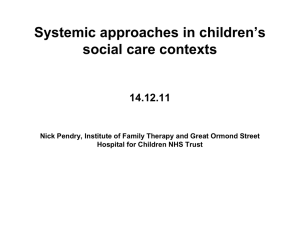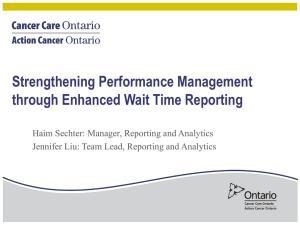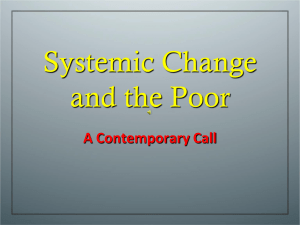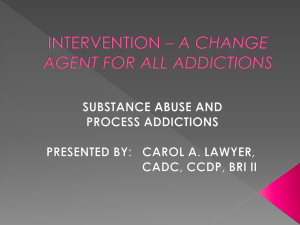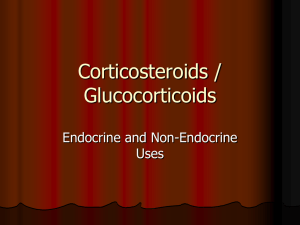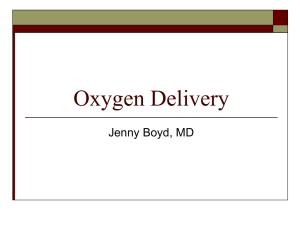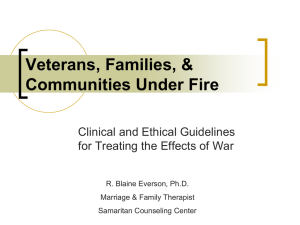Monitoring Heart-Kidney Interactions
advertisement
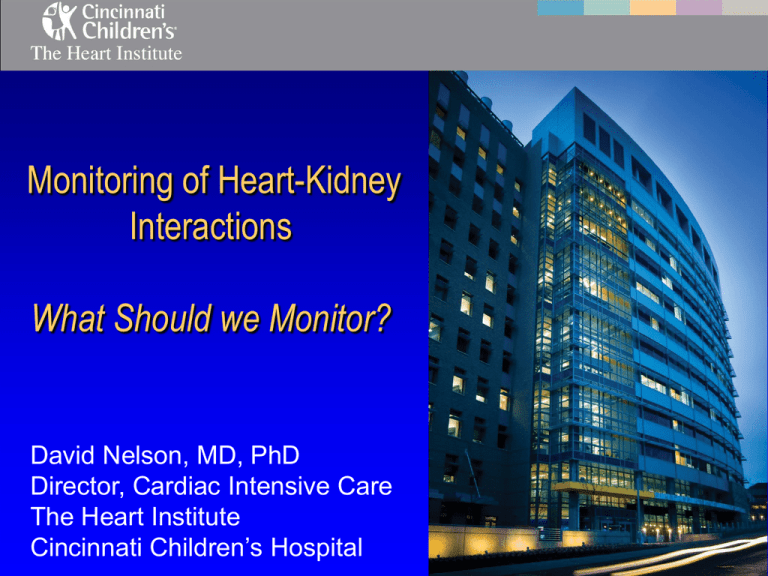
Monitoring of Heart-Kidney Interactions What Should we Monitor? David Nelson, MD, PhD Director, Cardiac Intensive Care The Heart Institute Cincinnati Children’s Hospital Is this the response to Low Cardiac Output Syndrome in your ICU? Survival is a necessary, but insufficient definition of outcome Increasing CICU Length of Stay in Associated with Lower Verbal and Full Scale IQ 8 Years After Surgery Longer Length of Stay 110 N=166 P < 0.02 105 When adjusting for predictors of longer CICU length of stay, as well as for prior variables that were predictive of worse 8 year developmental outcome: Longer CICU length of stay was associated with: Lower Full Scale IQ (P=0.02) Lower Verbal IQ (P=0.02) Lower Performance IQ (P=0.08) Lower Math Achievement (P=0.08) 100 95 90 Deleting top 5% of CICU LOS, each day in the CICU: Led to a reduction of 1.4 points in full scale IQ 85 1st Quartile 2nd 3rd Verbal IQ Full Scale IQ 4th Led to a reduction of 1.6 points in math achievement Quartile Boston Circulatory Arrest Study Newburger, Wernovsky et al, J Pediatr 2003;143:67-73 Neurologic Injury after Neonatal Congenital Heart Surgery 2% overt neurological injury following pediatric heart surgery 10% subclinical stroke in neonates undergoing surgery 60% visuospatial/motor abnormalities, attention deficit, developmental delay by school age following neonatal surgery HLHS survivors’ median IQ 66 – 57% cerebral palsy Physiologic Monitoring How effective is our current monitoring technology? What is the incidence of “unanticipated” cardiac arrest in your ICU? How quickly is LCOS detected in your ICU, and what is the sensitivity and specificity? When LCOS is detected in a patient, do the interventions minimize the duration of LCOS? Does monitoring cause complications (thrombosis, BSI’s, etc) Syste O2 Consu 150 What Should We Be Monitoring? 100 50 0 0 Assessment of Low Output States 500 1000 1500 Systemic O2 Consumption Lactate 14 300 12 250 10 200 8 150 6 100 4 50 2 00 00 500 500 1000 1000 1500 1500 Systemic O2 Delivery 14 Lactate 12 10 8 6 4 2 0 0 500 1000 Systemic O2 Delivery 1500 What is the best marker of inadequate O2 Delivery? Syste O2 Consu 150 What Should We Be Monitoring? 100 50 0 0 Assessment of Low Output States 500 1000 1500 Systemic O2 Consumption Lactate 14 300 12 250 10 200 8 150 6 100 4 50 2 00 00 500 500 1000 1000 1500 1500 Systemic O2 Delivery 14 Lactate 12 10 8 6 4 2 0 0 500 1000 Systemic O2 Delivery 1500 What is the best marker of inadequate O2 Delivery? What Should We Be Monitoring? Assessment of Low Output States Systemic O2 Consumption 300 250 What is the best marker of inadequate O2 Delivery? Lactate is “too late” 200 150 100 50 0 0 500 0 500 1000 1500 14 Lactate 12 10 8 6 4 2 0 1000 Systemic O2 Delivery 1500 What Should We Be Monitoring? Assessment of Low Output States Systemic O2 Consumption 300 250 What is the best marker of inadequate O2 Delivery? Lactate is “too late” The cardiac output needed depends upon the O2 Demand 200 150 Cardiac Output? 100 50 0 0 500 1000 1500 14 Lactate 12 10 8 6 4 2 0 0 500 1000 Systemic O2 Delivery 1500 Systemi O2 Consump 200 What is the best marker of inadequate Oxygen Delivery in shock states? 150 100 50 Mixed-venous O2 Saturation (SVO2) Systemic Mixed-venous 2 Consumption O2OSaturation (SVO2) 0 0 500 1000 1500 0 500 1000 1000 1500 1500 90 300 80 250 70 60 200 50 150 40 30 100 20 50 10 0 Systemic O2 Delivery 90 80 70 60 50 40 30 20 10 0 0 500 1000 Systemic O2 Delivery 1500 Systemi O2 Consump 200 What is the best marker of inadequate Oxygen Delivery in shock states? 150 100 50 0 Systemic Mixed-venous 2 Consumption O2OSaturation (SVO2) 0 90 300 80 250 70 60 200 50 150 40 30 100 20 50 10 0 1000 1500 Hypoxic hypoxia Anemia Hypovolemia Carbon Monoxide Dysoxia 0 Mixed-venous O2 Saturation (SVO2) 500 500 1000 1000 1500 1500 Systemic O2 Delivery 90 80 70 60 50 40 30 20 10 0 0 500 1000 Systemic O2 Delivery 1500 What is the best marker of inadequate Oxygen Delivery in shock states? Systemic O2 Consumption 300 250 200 Hypoxic hypoxia Anemia Hypovolemia Sepsis 150 100 50 Mixed-venous O2 Saturation (SVO2) 0 0 500 1000 1500 0 500 1000 1500 90 80 70 60 50 40 30 20 10 0 Systemic O2 Delivery Regardless of the cause, SVO2 is the best marker of inadequate systemic and regional O2 delivery and anaerobic metabolism We don’t need no new monitors! What data is there to support monitoring of blood pressure or heart rate? We tend to have different standards for new technology than for the old technology. Diagnosis of low output states Clinical Signs of Low Output Pallor Tachycardia If present then Tachpnoea Altered mentation tissue hypoxia GI distress is already Olguria/Anuria occuring Acidosis Lactate Falling Venous or regional O2 saturation ??? Capillary Refill and Toe Temperature Fail to predict Low Cardiac Output Tibby SM et al. Arch Dis Child 1999;80(2):163-6 “norm value for cap refill time of < or = 2 sec has little predictive value “ Bailey JM et al. Crit Care Med 1990;18(12):1353-6 “no signif relationship between cap refill or extremity (toe or finger) core temp gradients and cardiac index (CI)” Butt W et al. Anaesth Intensive Care 1991;19(1):84-7 “peripheral temp (toe temp), and core-peripheral temp difference …did not provide any guide to either CO or SVR.” Raju NV et al. Clin Pediatr (Phila) 1999;38(3):139-44 “no accepted standard for measuring decreased perfusion in the newborn “ 160 150 140 130 120 110 100 90 80 100 90 80 70 60 50 40 30 20 10 0 HR MAP SvO2 CVP CVP Heart Rate 170 MAP Pediatric Critical Care Med, 2008 Conclusions: 1 5 9 13 17 21 25 29 33 37 “We report the first case of Time a newly modified central venous catheter for (hr) children and demonstrate its utility in a patient with impaired oxygen delivery when traditional markers remain stable. This catheter enabled the rapid diagnosis of cardiac compromise due to pericardial effusion, leading to early treatment.” 10 90 9 80 8 70 7 60 6 50 5 40 4 30 3 20 2 10 1 0 0 1 5 9 13 17 21 25 29 33 37 41 Time(Hrs) Lactate ScvO2 100 ScvO2 Lactate Monitoring of Continuous Venous Oximetry is likely the “Gold Standard” for Cardiac Output Assessment Systemic O2 Consumption 300 250 SVO2 is the best marker of inadequate systemic and regional O2 delivery and anaerobic metabolism No Data on Continuous Oximetry and Acute Kidney Injury in Children 200 Hypoxic hypoxia Anemia Hypovolemia Sepsis 150 100 50 0 Mixed-venous O2 Saturation (SVO2) 0 500 1000 1500 90 80 70 60 50 40 30 20 10 0 0 500 1000 Systemic O2 Delivery 1500 Use of Cerebral rSO2 as non-invasive surrogate for mixed-venous saturation ???? Tortoriello et al, Pediatric Anesthesia, 200 Owens, Ped Cardiology 2011 Lactate Too Late Owens, Ped Cardiology 2011 Renal rSO2 Falls 4 hours Before Cardiac Arrest Owens, Ped Cardiology 2011 Physiologic Monitoring How effective is our current monitoring technology? What is the incidence of “unanticipated” cardiac arrest in your ICU? How quickly is LCOS detected in your ICU, and what is the sensitivity and specificity? When LCOS is detected in a patient, do the interventions minimize the duration of LCOS? Does monitoring cause complications (thrombosis, BSI’s, etc)
